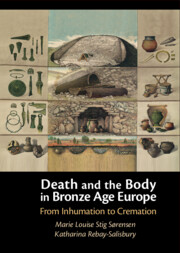Book contents
- Death and the Body in Bronze Age Europe
- Death and the Body in Bronze Age Europe
- Copyright page
- Contents
- Figures
- Tables
- Acknowledgements
- One Introduction
- Two A Brief History of Urns, Urnfields, and Burial in the Urnfield Culture
- Three Theoretical Framework
- Four The Bronze Age
- Five The Changing Bronze Age Body
- Six The Treatment of the Body
- Seven The Construction of Graves
- Eight After the Burial
- Nine Conclusions
- References
- Index
Seven - The Construction of Graves
Coherence and Variations
Published online by Cambridge University Press: 22 December 2022
- Death and the Body in Bronze Age Europe
- Death and the Body in Bronze Age Europe
- Copyright page
- Contents
- Figures
- Tables
- Acknowledgements
- One Introduction
- Two A Brief History of Urns, Urnfields, and Burial in the Urnfield Culture
- Three Theoretical Framework
- Four The Bronze Age
- Five The Changing Bronze Age Body
- Six The Treatment of the Body
- Seven The Construction of Graves
- Eight After the Burial
- Nine Conclusions
- References
- Index
Summary
There are several reasons why we decided to discuss the construction of the grave separately from the treatment of the body per se, while simultaneously maintaining an approach that sees them as interconnected. The main reason is that the two events are not necessarily done consecutively – they are not automatically linear in a temporal sense. The construction of the grave can begin independently of the cremation – it may be started before, during, or after the cremation and thus may imply difference and differentiation in terms of planning and involvement. The decisions made will reveal perceptions of the needs of the body, including views about, for example, ‘the afterlife’ of the deceased and what stages this involved, and they were also affected by various social needs. The second main reason is that there is an architectural and material aspect to the construction of the grave, which affected both its links to tradition and created possibilities for symbolism and metaphorical connotations (see also Harding 2000: 113). In addition, drawing on architectural similarities with other constructions, such as houses, pits, or earlier graves, was not only one of the main ways of creating an understanding of the grave as a resting place, it was also a way of using the vocabulary of the familiar in the construction of (new) meanings: similes and similarities were probably some of the main means of creating shared meanings and ontological security around grave constructions. These links helped to assure that the changes in practices and forms were done in a manner that retained a sense of familiarity, benefitting from a notion of being knowledgeable of cultural practices. We suggest this as a core mechanism that enabled the rapid and wide uptake of cremation. This is especially of importance because the change from inhumation to cremation challenged and altered established fundamental beliefs – cremation introduced a change to the treatment of the body and its subsequent appearance that was dramatic and absolute. As discussed in Chapter 6, during the transition phase various activities were carried out to counteract the impression of the cremated remains being substantively different to the body whole, but a cremated body is nonetheless radically different from an un-cremated one. In comparison, the grave constructions themselves did not necessarily constitute a similar radical choice, and the choices made were more open-ended.
- Type
- Chapter
- Information
- Death and the Body in Bronze Age EuropeFrom Inhumation to Cremation, pp. 149 - 173Publisher: Cambridge University PressPrint publication year: 2023



